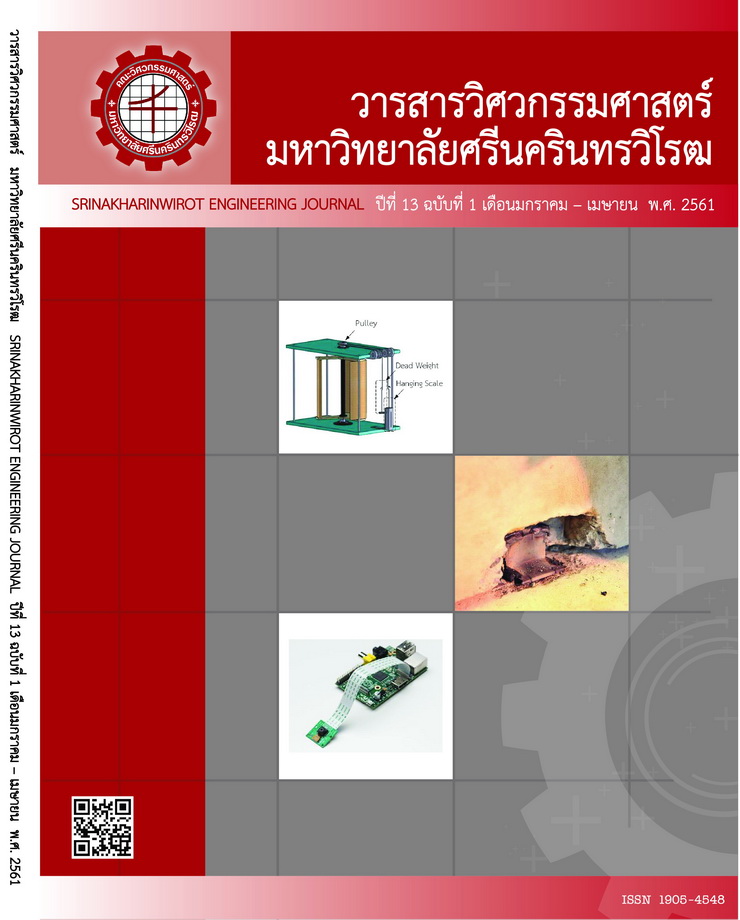A Phantom Simulation of Thoracic for Medical Image Processing Study
Main Article Content
Abstract
A mathematical phantom is a simple method to simulate the organs of the human body. A phantom can simulate organs such as the chest, lung, bone, and muscle. The information for this phantom was gained from real organs captured by computed tomography (CT) images. The purpose of this study was to create a human thoracic phantom. The image data of the simulation phantom images was compared to CT images from the database: Radiopedia. Thirty-four slices of CT images were referenced. The simulated organs were similar to the organs in the CT images. The line profiles and the intensity value of the simulated images and the reference images were compared. The qualitative evaluation of profile and intensity value and intensity value of lungs, heart and bone were not significantly different (P<0.050). The intensity of blood vessels was significantly different (P>0.05). The assessment of three experts in human anatomy on the simulated image and the database image were moderately similar. In conclusion, the phantom simulation images were similar to CT images from the database. Therefore, the phantom may be used to test algorithms in medical image processing.
Article Details
Copyright belongs to Srinakharinwirot University Engineering Journal
References
[2] J. Panés, R. Bouzas, M. Chaparro, V. García-Sánchez, J. P. Gisbert, B. Martínez de Guereñu, J. L. Mendoza, J. M. Paredes, S. Quiroga, T. Ripollés, and J. Rimola, “Systematic review: the use of ultrasonography, computed tomography and magnetic resonance imaging for the diagnosis, assessment of activity and abdominal complications of Crohn’s disease,” Aliment Pharmacol. Ther., vol. 34, no.2, pp. 125–145, 2011.
[3] M. Karçaaltincaba and A. Aykut, “Dual-energy CT revisited with multidetector CT: review of principles and clinical applications,” Diagn. Interv. Radiol., vol. 17, no.3, pp. 181-194, 2011.
[4] Z. Ma, J.R.S.Tavares, R.N. Jorge, and T. Mascarenhas, “A review of algorithms for medical image segmentation and their applications to the female pelvic cavity,” CMBBE, vol. 13, pp. 235-246, August 2010.
[5] F. P. M.Oliveira and J. R. S. Tavares, “Medical image registration: a review,” CMBBE, vol. 17, pp. 73-93, March 2014.
[6] I.Sechopoulos, “A review of breast tomosynthesis. Part II. Image reconstruction, processing and analysis, and advanced applications,” Med Phys, vol. 40, no.1, pp. 1-17, 2013.
[7] Radiology Support Devices, The Alderson Radiation Therapy phantom. (2016, Jan 20). [Online]. Available: http://www.rsdphantoms. com/rt_art.htm
[8] L.A.Shepp and B.F.Logan, “The fourier reconstruction of a head section,” IEEE Trans Nucl Sci, vol. 21, pp. 21–43, June 1974.
[9] B.D. Muzio. (2016, Jan 29). Normal chest CT, [Online]. Available: http://www. radiopaedia. org/cases/normal-chest-ct-1
[10] Matlab. (2016, Feb 29 ). Create head phantom image, [Online]. Available:http://www.mathworks.com/ help/images/ ref/phantom.html
[11] ImageJ. (2016, May 2). ImageJ program, [Online]. Available: https://imagej.nih.gov/ij/
[12] Matlab. (2016, Feb 29 ). Add noise to image, [Online]. Available: http://www.mathworks. com/help/images /ref/ imnoise.html
[13] Matlab. (2016, Feb 29 ). Image filter [Online]. Available: https://www.mathworks.com/help /images /ref/imfilter.html
[14] Matlab. (2016, Feb 29 ). Global image threshold using Otsu's method [Online]. Available: https:// www.mathworks.com/ help/images /ref/graythresh.html
[15] Matlab. (2016, Feb 29). Multilevel thresholding Online]. Available:://www.math works.com/ help/images/ref/ grayslice.html
[16] Matlab. (2016, Feb 29 ). Concatenate arrays along specified dimension [Online]. Available: https://www.mathworks.com/help/matlab/ref/cat.html
[17] X. Liang, Z. Zhang, T. Niu, S. Yu, S. Wu, Z. Li, H. Zhang, and Y. Xie, “Iterative image-domain ring artifact removal in cone-beam CT,” Phys Med Biol, vol. 62, pp. 5276-5292, June 2017.
[18] S. Li, E. T. Quinto, W. Shiqiang, and J. Ming, “Simultaneous reconstruction and segmentation with the mumford-shah functional for electron tomography,”in IEEE Engineering in Medicine and Biology Society Annual Conference, Florida, 2016, pp.5909-5912.
[19] A. Singer and H.T. Wu, “Two-dimensional tomography from noisy projections taken at unknown random directions,” SIAM J Imaging Sci, vol. 6, no.1, pp. 136-175, 2013.
[20] T. Kaewlek, D.Koolpiruck, S. Thongvigitmanee, M. Mongkolsuk, S.Thammakittiphan, S.O. Tritrakarn, and P. Chiewvit, “Metal artifact reduction and image quality evaluation of lumbar spine CT images using metal sinogram segmentation,” J XRay Sci Technol, vol. 23, pp. 649-666, no.6 2015.
[21] Z. Messali, N. Chetih, A. Serir, and A. Boudjelal, “A quantitative comparative study of back projection, filtered back projection, gradient and bayesian reconstruction algorithms in computed tomography (CT),” IJPS, vol. 4, no.1, pp. 12-31, 2015.
[22] P. H. Pretorius, M. A. King, B. M. Tsui, K.J. LaCroix, and W. Xia, “A mathematical model of motion of the heart for use in generating source and attenuation maps for simulating emission imaging,” Med Phys, vol. 26, no.11, pp. 2323-2332, 1999.
[23] Division of Medical Imaging Physics, Johns Hopkins Medical Institutions, USA. (2016, June 3). Medical Imaging Simulation Techniques and Computer Phantoms [Online]. Available: http://dmip1.rad.jhmi. edu/xcat/


